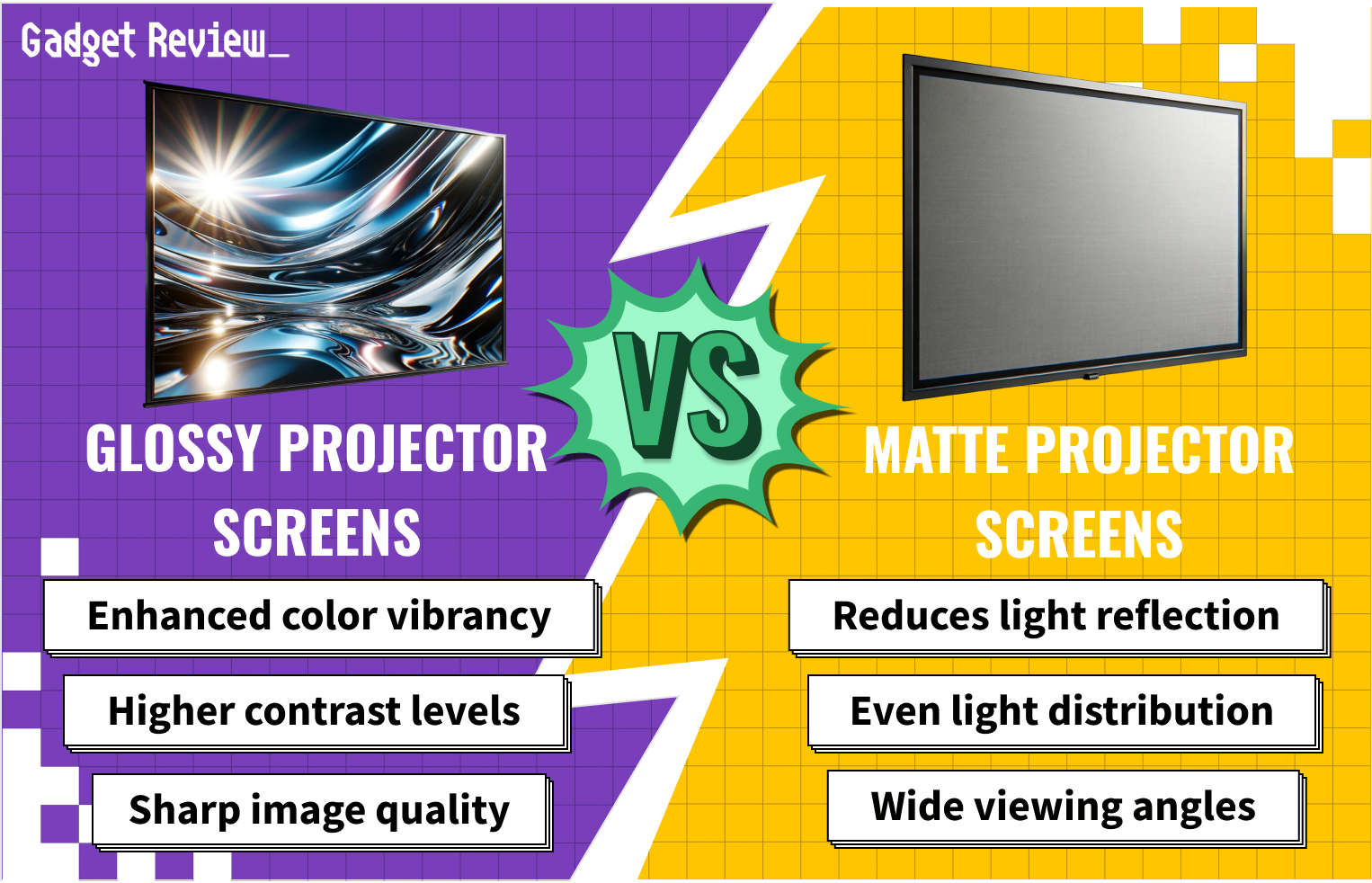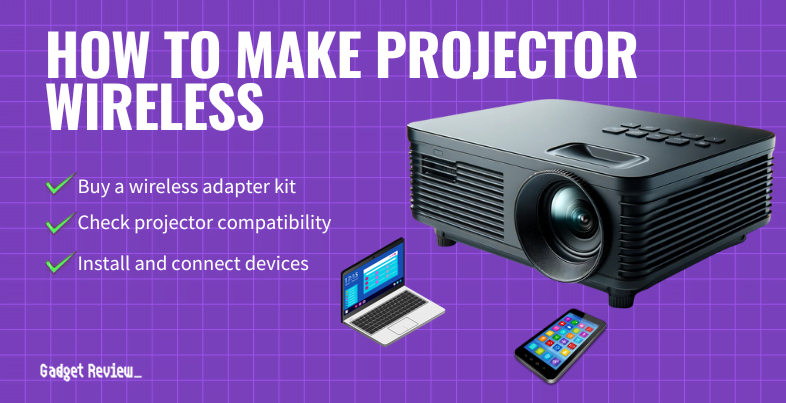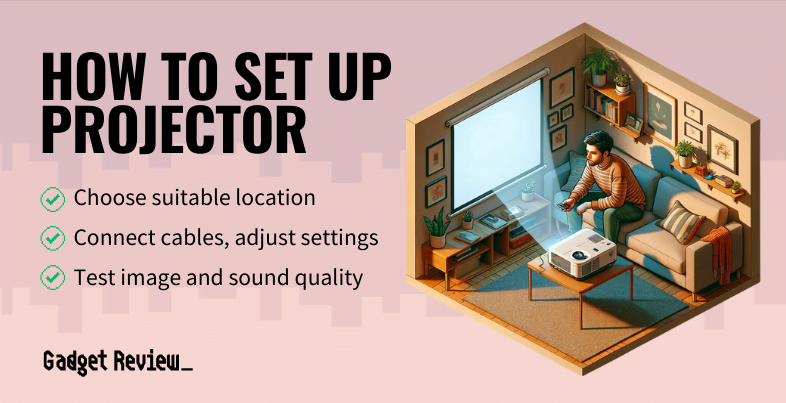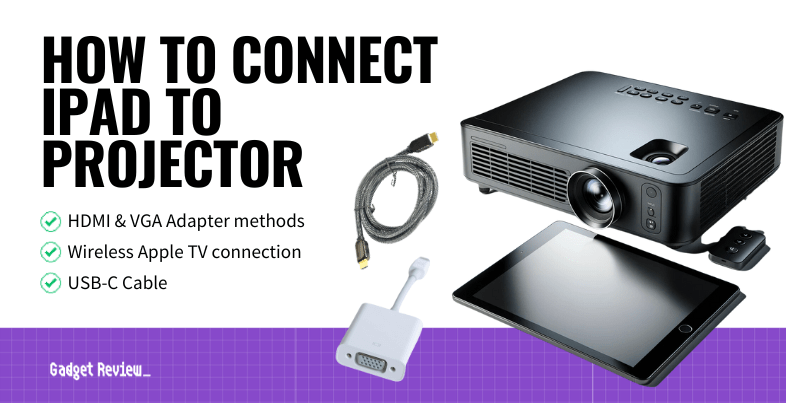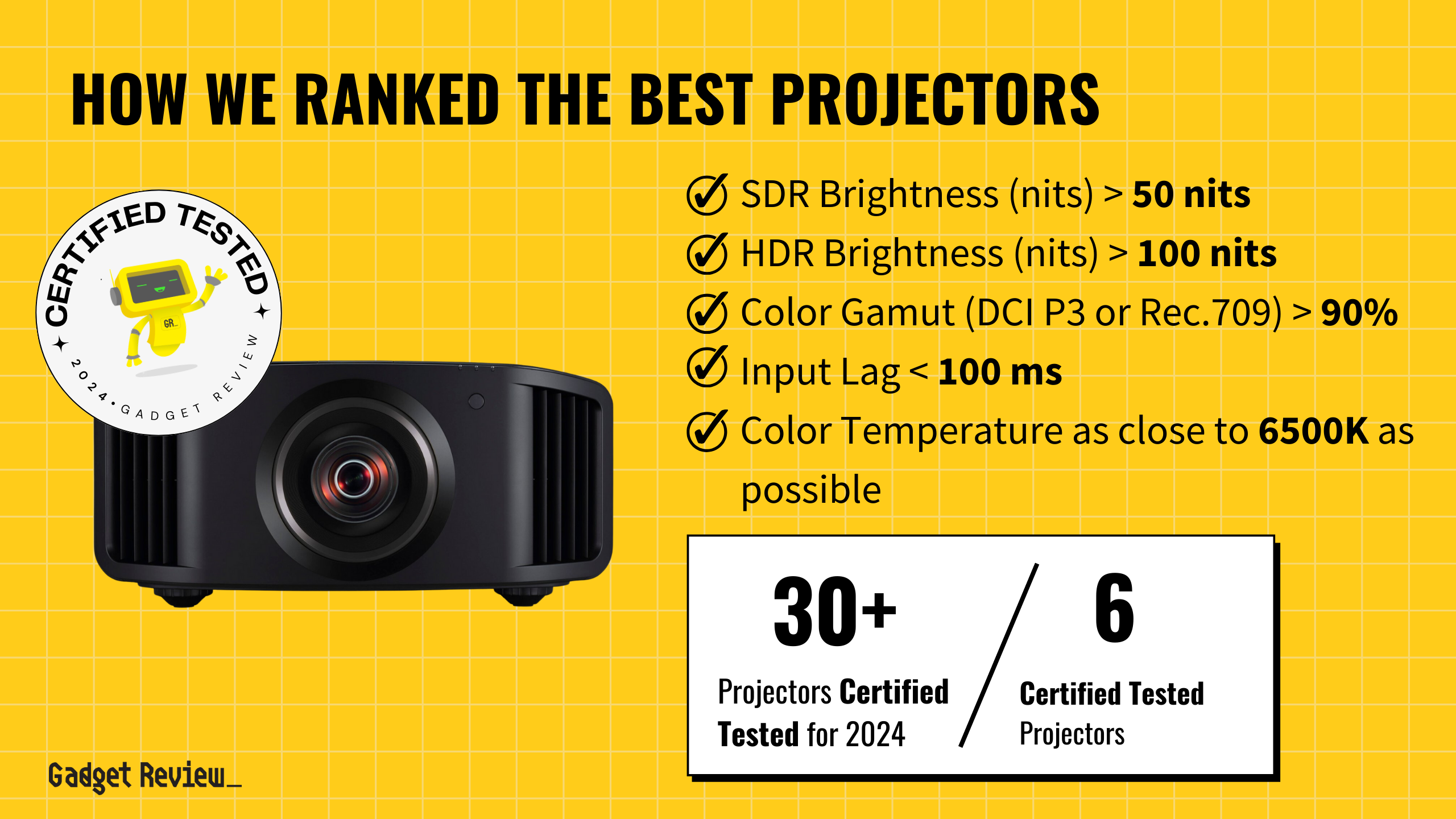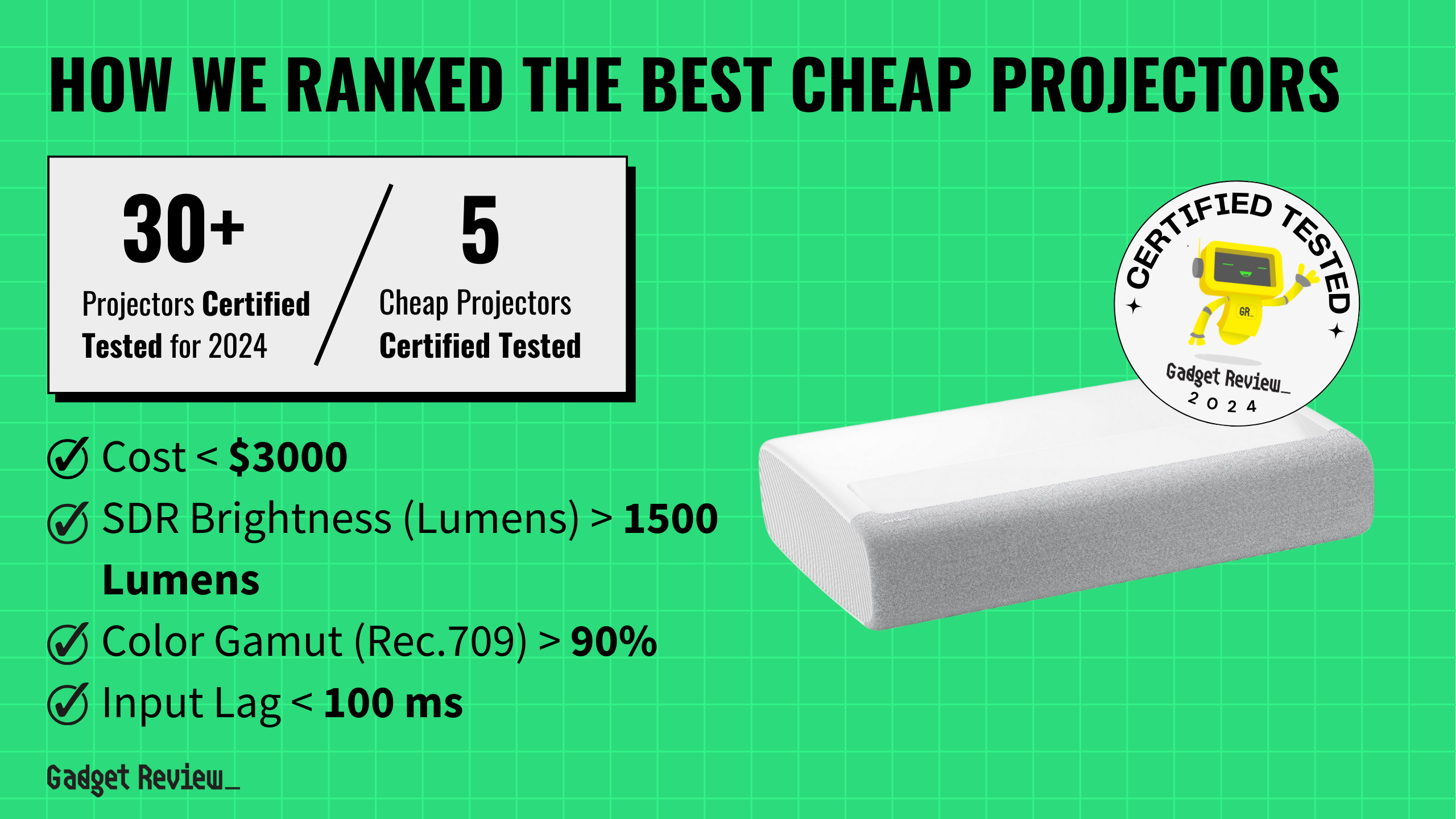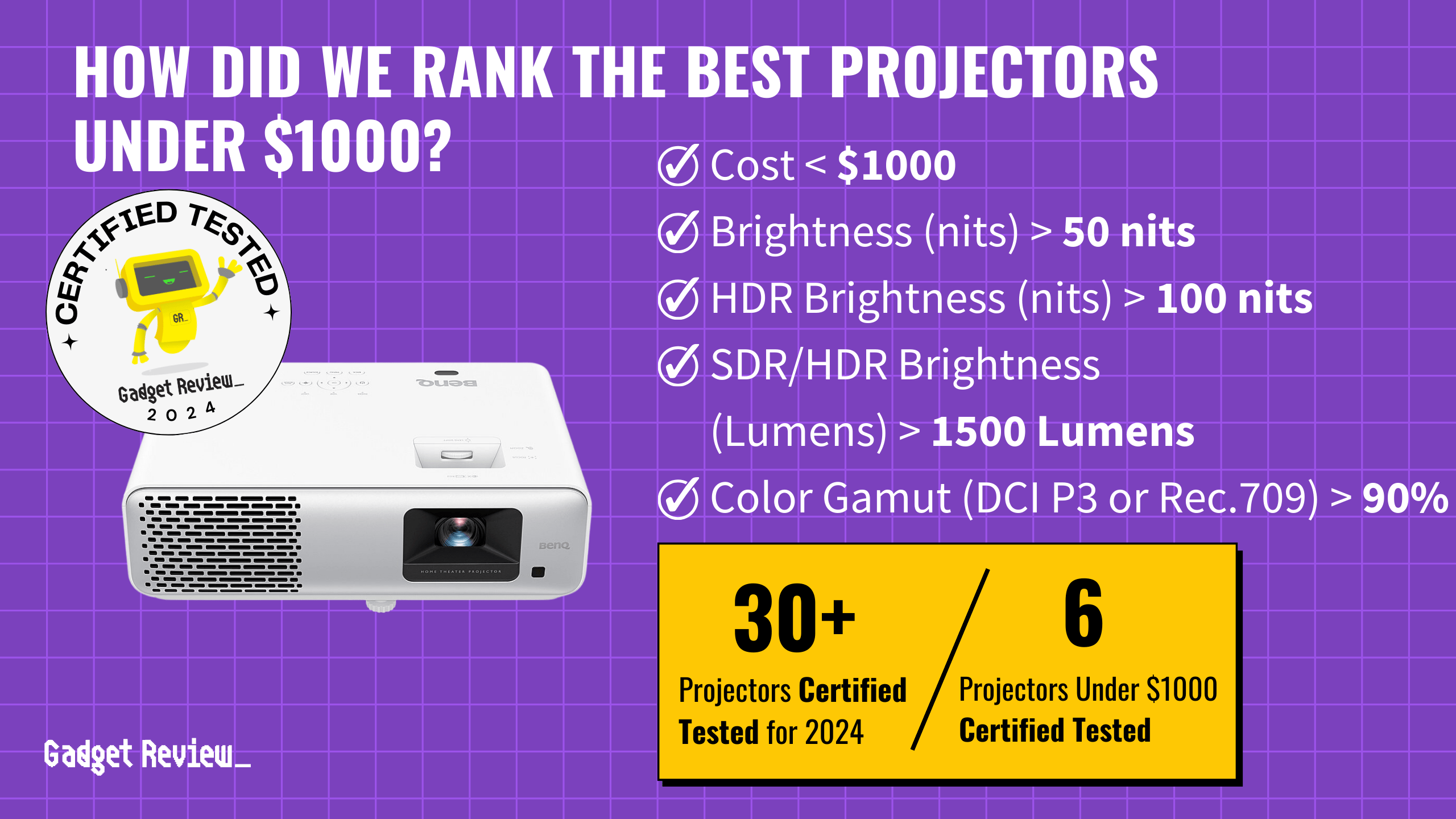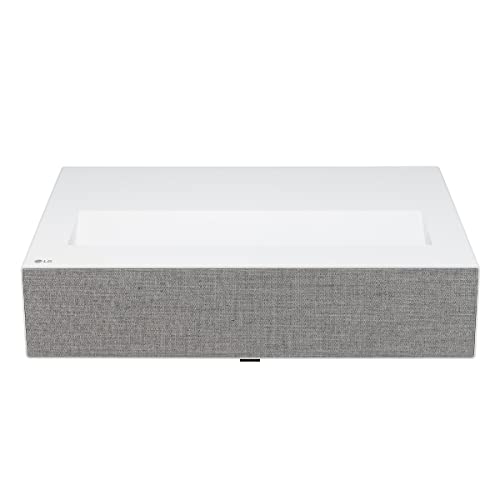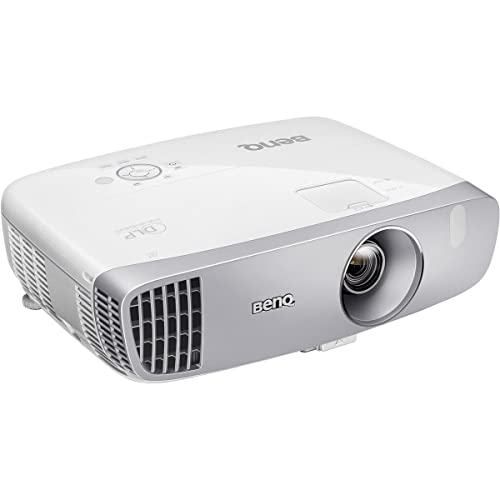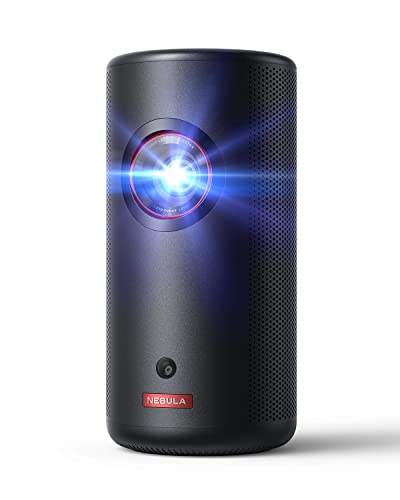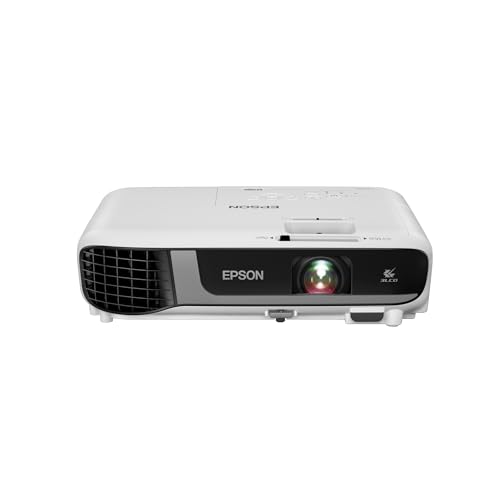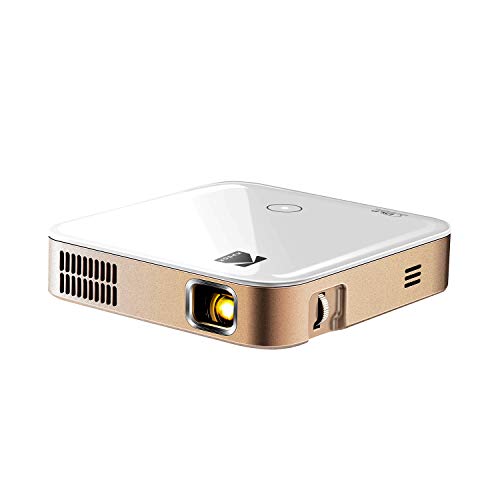When watching sports, you need a good quality projector that excels in brightness and color accuracy to handle fast-paced action and ambient light. Look for models offering SDR brightness over 1500 lumens and Rec.709 color gamut coverage exceeding 90% to ensure vibrant, clear images. Low input lag below 100 milliseconds is crucial for seamless, real-time viewing.
We evaluated 30 projectors, analyzing 10,299 reviews to select three top performers for our buying guide. Our unique approach certifies products as tested and uses proprietary AI-powered Trust Score to filter out fake and low-quality reviews. The winning projectors performed exceptionally in tests, ensuring an immersive sports viewing experience.
How Did We Rank the Best Projectors for Sports?
Our buying guide for the Best Projectors for Sports leverages extensive research from over 200 websites. We examined various testing methods and combined this with customer reviews to pinpoint the essential features for sports viewing. We distilled the criteria into 3 required test results and 1 nice-to-have feature using expert reviews and our unique true score system. This thorough analysis guarantees that our top projector picks offer superior image quality, fluid motion, and vivid color reproduction, enhancing your sports-watching experience.
Our commitment to unbiased reviews is powered by our ‘True Score’ system, targeting low quality and fake reviews. When you shop through our links, you’re backing our mission. Dive deeper to see how.
? Test Criteria
- SDR Brightness: Equal to or greater than 50 nits, ensuring a bright and clear display.
- HDR Brightness: 100 nits or more, to reveal the finest details in high dynamic range content.
- Color Gamut: At least 90% of the Rec. 709 color gamut, providing rich and vibrant colors.
? “Nice To Haves”
- Input Lag: An input lag of less than 100 milliseconds, to prevent delays between what’s on screen and your reaction to them in games.
Latest Updates
- 05/08/2024: Published the list of best projectors for sports based on our True Score system.
Top Projectors for Sports For 2025
Prices accurate at the time of publishing

Best Overall

Runner Up

Best Value

Best Budget

Best Mid-Range

Premium Pick
Sony VPL-XW5000ES-B
The Sony VPL-XW5000ES-B is an outstanding 4K projector with vivid, lifelike colors and smooth visuals for sports, gaming, and movies.
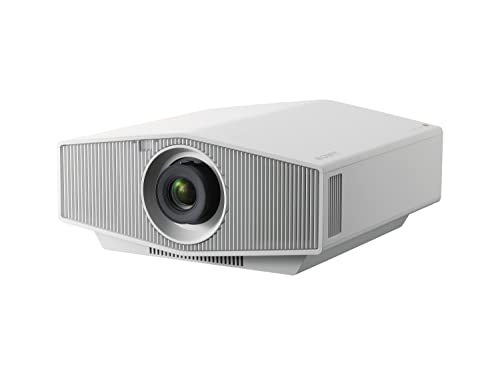
True Score
89918Experts
92125Customers
Absolutely Fresh
 SAVE $1$5,998.00$4,998.00
SAVE $1$5,998.00$4,998.00Read More
Snapshot
Reasons to Buy
- Great brightness rating
- Good image quality
- Low input lag
Reasons to Avoid
- Cannot render HDR10+ content
- No HDMI 2.1 ports
Specifications

Resolution 3840 x 2160 (4k) Refresh Rate 60 Hz 
Display Technology SXRD 
Contrast Ratio ∞:1 
Digital Keystone No 
HDR HDR10, Hybrid Log-Gamma (HLG) 
Max Distance 26.52″ 
Max Screen Size n/a 
3D Ready No 
Aspect Ratio 16:9 
Brightness 2000 Lumens 
Depth 18.59″ 
Height 7.9″ 
Integrated Speakers No 
Light Source Laser 
Light Source Life 20000 hrs 
Min Distance 16.56″ 
Min Screen Size n/a No – 
Noise Level 24 dB 
Portable No 
Smart Functionality No 
Sync Technology No 
TV Tuner No 
ThrowType Standard Throw 
Video Inputs HDMI 2.0 
Weight 28 lbs 
Width 18.5″ All Specs
Test Results
SDR Brightness (Lumens) 1,598 HDR Brightness (Lumens) 0 Contrast Ratio (x:y) 8,703 Input Lag (ms) 28 Color Gamut % (Rec. 709) 121 Color Gamut % (DCI P3 uv) 82 All Retailers
- $4,998.00$5,998Save $1
- $4,999.99$6,000Save $1
Our Verdict
Avid sports fans who want a projector with accurate colors should take note of the Sony VPL-XW5000ES-B, which delivers superior Rec 709 coverage. It has an unbeatable 120.7% Rec 709 coverage, the color space widely used for broadcasting sports, and it ensures that the colors you see on screen are more vivid and true-to-life. Its color coverage of 81.72% for DCI P3 uv also reproduces a wide range of colors for your movies and video games. Its contrast ratio of 8,703:1 ensures deep blacks and bright whites, offering a rich and detailed viewing experience that brings depth and dimension to images.
It provides 273.2 nits of HDR brightness and 273.4 nits of SDR, along with a lumens output of 1598 for SDR content. It’s a solid pick if you’re both a sports enthusiast and an outdoor movie host who needs clear, vibrant visuals while dealing with ambient light. It also delivers an unmatched input lag of 27.9ms to ensure a smooth gaming experience.
Comparing it to the Formovie Theater projector, both projectors boast 4K resolution. The Sony has a higher Rec 709 color coverage, making it more suitable for sports with vivid colors. The Formovie, on the other hand, has a higher DCI-P3 color gamut and higher brightness, ensuring brighter, more accurate colors for movie fans.
If you’re a sports fan, gamer, and movie buff, the Sony VPL-XW5000ES-B’s performance caters well to a variety of uses thanks to its brightness, contrast, and color reproduction. While the price is high, it’s still a fantastic investment if you prioritize superior picture quality and smooth movement.
Read Less

DON’T SEE WHAT YOU’RE LOOKING FOR?
For a complete home theater experience, explore our guide to the top-rated projector screens, ensuring you get the most out of your projector. If you’re short on space or need portability, check out our picks for the best mini projectors.
For a permanent setup, consider quality ceiling-mounted projectors, which offer a seamless integration into your room. Additionally, we review the top short throw projectors, perfect for smaller spaces where distance from the screen is limited.

Best Overall

Runner Up

Best Value

Best Budget

Best Mid-Range

Premium Pick
Epson Home Cinema 3800
Best For Epson
Epson Home Cinema 3800 delivers vibrant visuals and deep contrasts, perfect for bright rooms and fast-paced games, all at great value.
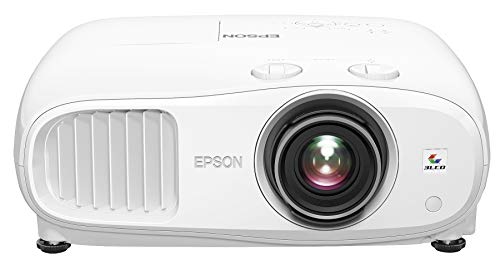
True Score
83846Experts
871kCustomers
Absolutely Fresh
 $1,643.99
$1,643.99Read More
Snapshot
Reasons to Buy
- Great brightness
- Great image quality
- 4K resolution
Reasons to Avoid
- Lacks a wide color gamut
- The lamp output may not match the specs
- Mediocre 28-ms input lag
Specifications

Resolution 1920 x 1080 (Full HD) Refresh Rate 60 Hz 
Display Technology 3LCD, LCD 
Contrast Ratio 100,000:1, 200,000:1 
Digital Keystone ± 30° (manual) 
HDR No, Yes 
Max Distance 300″ 
Max Screen Size 300″ 
3D Ready No, Yes 
Aspect Ratio – 
Brightness 3000 lumens 
Depth 13″ 
Height 6.5″ 
Integrated Speakers No, Yes 
Light Source UHP lamps 
Light Source Life 3,500 hrs 
Min Distance 0″ 
Min Screen Size 40″ No – 
Noise Level 35 dB 
Portable No, Yes 
Smart Functionality Automatic Adjustments, Bluetooth, Eco-Friendly, Energy-Saving, Remote, USB 
Sync Technology VRR 
TV Tuner No, Yes 
ThrowType 1.32 to 2.15:1. 
Video Inputs HDMI 2.0, USB, VGA 
Weight 15.2 lbs 
Width 16.1″ All Specs
Test Results
SDR Brightness (Lumens) 2,176 HDR Brightness (Lumens) 0 Contrast Ratio (x:y) 24k Input Lag (ms) 28 Color Gamut % (Rec. 709) 114 Color Gamut % (DCI P3 uv) 77 All Retailers
- $1,643.99
- $1,699.99
- $1,699.99
- $1,699.99
Our Verdict
If you’re looking for a budget-friendly projector that provides amazing contrast and brightness, the Epson Home Cinema 3800 offers great value. Sporting a brightness of 2,176 lumens for SDR content, a superior 275.2 nits for SDR, and 235.4 nits for HDR, it ensures vibrant and clear visuals in bright living rooms and classrooms. It also has a superior contrast ratio of 23,971:1, projecting vivid, crisp images with deep black and bright whites in homes and offices.
If you’re a competitive gamer who prioritizes minimal delay in action games, the Epson’s 28ms input lag keeps you in sync with the real-time thrill. Paired with 113.7% coverage of the Rec. 709 color gamut suited for sports, it promises speed and color fidelity, ensuring that every sports game is vibrant and true to life.
Compared to the Sony VPL-XW5000ES-B, both have excellent input lag and are great for video games. The cheaper Epson Home Cinema 3800 has better brightness and contrast, making it good for rooms with varying light levels, offering clear visibility and depth. The Sony has more vivid colors for sports and movies if you prioritize vibrant and colorful visual quality.
This projector’s blend of price, high brightness, substantial contrast, and quick input response make it a top contender for sports viewing, gaming, and movies. Though it doesn’t offer the most colorful visual quality, it’s still a reliable and versatile solution if you need minimal lag and excellent visual quality without the premium cost.
Read Less
Category Snapshot
Projectors
- Total Brands/Products Tested
11 Brands, 30 Products
- Top 2 Brands
Epson, BenQ
- Price Range (Budget-Premium)
$350-$16,000
- Average True Score
81.36
- Important Test Criteria
Brightness (cd/m2)
Contrast Ratio (1000:1) - Most Trusted Testers

- Top Projector Experts
- Typical Warranty
1 year
- Covered by Insurance
Yes – AKKO

Best Overall

Runner Up

Best Value

Best Budget

Best Mid-Range

Premium Pick
Formovie Theater
Best For Short Throw
Despite its price and input lag, the Formovie Theater excels in bright rooms with vivid colors and clear imagery for both sports and movies.
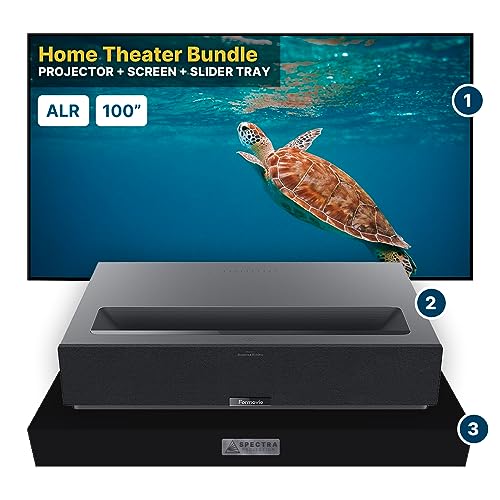
True Score
79818Experts
8343Customers
Mixed Reviews

Read More
Snapshot
Reasons to Buy
- Satisfying brightness rating
- Good image quality
- Low latency
Reasons to Avoid
- Poor color accuracy out-of-the-box
- No lens shift adjustability
Specifications

Resolution 3840 x 2160 (4k) Refresh Rate 60 Hz 
Display Technology TI DLP 
Contrast Ratio 3,000 : 1 
Digital Keystone No 
HDR Dolby Vision, HDR10, HDR10+ 
Max Distance 19″ 
Max Screen Size 150″ 
3D Ready No 
Aspect Ratio 16:9 
Brightness 2800 Lumens 
Depth 13.78″ 
Height 4.3″ 
Integrated Speakers Yes 
Light Source Laser 
Light Source Life 20000 hrs 
Min Distance 5.51″ 
Min Screen Size 80″ 
Noise Level 28 dB 
Portable No 
Smart Functionality Yes 
Sync Technology – 
TV Tuner No 
ThrowType Ultra Short Throw Technology 
VRR n/a 
Video Inputs USB 
Weight 21.6 lbs 
Width 21.6″ Yes – All Specs
Test Results
SDR Brightness (Lumens) 2,837 HDR Brightness (Lumens) 2,676 Contrast Ratio (x:y) 1,917 Input Lag (ms) 41 Color Gamut % (Rec. 709) 100 Color Gamut % (DCI P3 uv) 107 All Retailers
Our Verdict
If you want a 4K projector that delivers exceptional sports and movie experiences in bright rooms, consider the Formovie Theater. With its superior SDR brightness of 2,837 lumens and HDR brightness of 2,676 lumens, the Formovie provides cinematic quality in a bright space. It features SDR and HDR brightness levels of 124.6 nits and 105.4 nits, respectively, which could be better. These figures offer clarity, but the projector best suits darker rooms like home theaters. Given its high lumens, it’s reliable in bright spaces to an extent, but its image vividness is underwhelming in very bright rooms.
It provides an unmatched color gamut of 106.81% DCI P3 uv, ideal for professional video editing and production, where vibrant and accurately represented colors are crucial. It achieves 100% coverage of the Rec. 709 color gamut, ensuring true-to-life color reproduction for sports broadcasts. With a contrast ratio of 1,917:1, it offers deep blacks and bright whites, adding depth to the image quality. However, the input lag of 41ms may not be the first choice for video games where every millisecond counts.
Compared to the Sony VPL-XW5000ES-B, both projectors have 4K resolution and have premium prices. The Sony is suited for sports and video games due to its lower input lag and higher Rec 709 coverage. The Formovie excels in rooms with ambient light, like classrooms and conference rooms, with its higher lumens, and it provides superior movie experiences with its DCI-P3 color coverage.
If you’re a sports fan or business professional who deals with ambient light, this projector is a reliable option. Despite its price and input lag, which isn’t ideal for competitive gaming, it has excellent color accuracy and brightness if you live in a bright room and prioritize high-quality visuals.
Read Less
Which Criteria Matters for Testing Best Projectors for Sports?
By prioritizing these criteria (2 essential, 1 desirable), individuals can efficiently compare these projectors and their performance. This facilitates making well-informed decisions and acquiring a projector that fulfills all requirements.
| CRITERIA | RANGE | REQUIRED | DEFINITION |
|---|---|---|---|
| SDR Brightness (lumens) | > 1000 nits | Yes | The amount of light the projector outputs from the lamp/bulb and projects onto the screen when playing SDR content. |
| HDR Brightness (lumens) | > 100 nits | Yes | The amount of light the projector outputs from the lamp/bulb and projects onto the screen when playing HDR content. |
| Color Gamut % (Rec. 709) | > 90% | Yes | The % of colors a projector can produce defined by the gamut. Rec. 709 is commonly used by HD TV, and is also known as BT.709. |
| Input Lag | < 100 ms | No (Nice to have) | The amount of time it takes for inputs to be registered and processed by the projector and shown on screen. |
Our Trusted Data Sources
We looked at 86+ projector reviewers and found that 16 are trustworthy (60%+ Trust Rating). The three we have listed below are our most trusted for projector.
- Pierre-Olivier Jourdenais – Rtings, LinkedIn
- Geoffrey Morrison – CNET, MuckRack
- Kam Valentine – Projector Reviews, MuckRack
Interested in a comprehensive analysis of our data sources? We’ve got you covered. Below, you’ll find a detailed list of every projector review website we’ve identified, organized by their respective Trust Ratings from highest to lowest. But we didn’t stop there. We’ve meticulously reviewed each publication and verified the data by checking whether the authors have bio links to MuckRack or LinkedIn. We’re committed to not only checking the facts but ensuring their veracity.
Projector Test Data & Results
Disclaimer:
Projectors are complex and difficult to test and evaluate, requiring extensive testing on the same level as televisions to paint a complete picture of how any given unit performs. Unfortunately, the testing behind projectors isn’t as rigorous, and a lot of the data we’ve compiled from expert reviewers has been incomplete at times. With different brightnesses measured from different sources, different color gamut tested and spotty contrast ratio measurements, we’ve done the best we can to leverage the available data when putting together these lists but have also trusted our True Score to help us make decisions when the data isn’t available.
1. SDR Brightness Test Results
Projectors have two ways you can realistically measure brightness: in lumens or in nits. Lumens are more common, but brightness in general matters because projectors have to project light strongly enough that it overcomes ambient light without losing detail or color.
Most of the time, a projector is going to be used in a fairly dark room to help give the unit the best chance of displaying content the way it was intended, but higher lumens output let you watch content in progressively bright spaces – or across longer distances on bigger screens. For standard dynamic range content, we recommend at least 1000 lumens for most home applications, but more isn’t a bad thing, and 3000 lumens or more are ideal.
SDR Brightness (lumens)
> 50 nits
Acceptable range of performance
Definition: The amount of light the projector outputs from the lamp/bulb and projects onto the screen when playing SDR content, measured in lumens.
Units of Measurement: Lumens
Tools to Measure: Lux meter
Why It’s Important:
Lumens affect how an image is going to look when projected on a screen. If the projector isn’t putting out enough light, the image quality will suffer.
SDR Brightness (lumens; higher is better; 0 = No Data)
2. HDR Brightness (lumens) Test Results
HDR Brightness (nits)
> 100 nits
Acceptable range of performance
Definition: The amount of light the projector outputs from the lamp/bulb and projects onto the screen when playing HDR content, measured in lumens.
Units of Measurement: Lumens
Tools to Measure: Lux meter
Why It’s Important:
Lumens affect how an image is going to look when projected on a screen. If the projector isn’t putting out enough light, the image quality will suffer.
High dynamic range content requires enough light to make the dramatic differences in a scene actually stand out. Otherwise, the same rules that would apply to SDR brightness apply here.
You’ll want a HDR brightness of 100 nits at least to use the projector and enjoy HDR content the way it was intended, but a higher brightness is always nicer. Low brightness will make content look dimmer, less vibrant and can cause the image to completely disappear if the ambient light is too strong.
HDR Brightness (lumens; higher is better; 0 = No Data)
3. Color Gamut % (Rec. 709) Test Results
If you watch a lot of high-definition TV such as HD sports, you’ve experienced the Rec.709 gamut. This gamut is employed mostly by HD television, so covering as much of it as you can is ideal. Fortunately, the Rec.709 gamut is smaller than the DCI-P3 gamut, so if you have good coverage of DCI-P3, it’s very likely you have good coverage of Rec.709. This gamut is also known as BT.709.
Regardless, we recommend you have a Rec.709 coverage of at least 90%, especially if HD TV is what you spend most of your time watching. Not covering enough of the gamut directly contributes to seeing inaccurate colors on things like sports uniforms or otherwise vibrant sets on your favorite TV shows.
Color Gamut % (Rec. 709)
> 90%
Acceptable range of performance
Definition: The % of colors a projector can produce defined by the gamut.
Units of Measurement: % (percentage)
Tools to Measure: Software
Why It’s Important:
This gamut is commonly used by HD TV, so covering it is necessary if you watch a lot of HD content.
Color Gamut Rec. 709 (%; higher is better; 0 = No Data)
4. Input Lag (ms) Test Results
Input Lag (ms)
< 100 ms
Acceptable range of performance
Definition: The amount of time it takes for inputs to be registered and processed by the projector and shown on screen.
Units of Measurement: ms (milliseconds)
Tools to Measure: Input lag tool
Why It’s Important:
Low input lag is important to reduce delay when gaming.
Input lag is primarily an issue when it comes to playing video games on your projector. If you’re trying to enjoy fast-paced shooters or are using projector to play competitive modes, you’ll need a low input lag to “keep the projector out of your way”, so to speak. High input lag causes delays in your inputs and makes it harder to react to action on screen because your own physical reactions start to count for less than the projector’s ability to process what you’re doing.
For this reason, we recommend an input lag of 100 ms or less, but lower is always better, and for really competitive games we’d recommend less than 15 ms. Any more than that and your projector is better suited to playing games casually, though if you don’t play anything fast paced, input lag is less of an issue.
Input Lag (ms; lower is better; 0 = No Data)
Best Projectors for Sports: Mistakes To Avoid
- Low Brightness: Don’t overlook brightness. Sports often have fast-paced action, and a dim image can make it difficult to follow. Look for projectors with high lumens ratings, especially if you plan to watch in a well-lit room or during daytime. This is especially important if you plan on using it as an outdoor projector that’s exposed to direct daylight and ambient light conditions.
- Low Resolution: Opting for a projector with low resolution can lead to a lack of detail, making it hard to see the ball or follow the action, especially for larger screen sizes. Aim for at least 1080p resolution, or even higher if your budget allows. If you prefer more affordable models, check out our picks of excellent budget projectors that won’t break the bank.
- Laggy Response Time: Gaming projectors often have low input lag, which is essential for sports viewing, particularly if you’re a fan of fast-paced sports like football or basketball. High input lag can lead to a noticeable delay between the action on the field and what you see on the screen.
- Poor Contrast Ratio: A low contrast ratio can result in muddy or washed-out images, particularly during night games or darker scenes. Look for projectors with high contrast ratios to ensure vibrant colors and deep blacks.
The Best Projectors for Sports Tests Compared
Product |
True Score
|
SDR Brightness
|
HDR Brightness
|
Contrast Ratio
|
Color Gamut % (DCI P3 uv)
|
Input Lag (ms)
| |
|---|---|---|---|---|---|---|---|
89 |
|
|
|
|
| $4,998.00 $5,998 $1 | |
| 83 |
|
|
|
|
| $1,643.99 |
| 79 |
|
|
|
|
|








